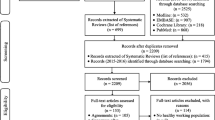Abstract
Background
Assessment of the level of exposure to work-related musculoskeletal disorders (WMSDs) risk factors can be an appropriate basis for planning and implementing an interventional ergonomics program in the workplace. This study was conducted among workers of Nag Hammadi sugar factory to investigate the relation between prevalence of WRSDs and years of job experience among factory workers.
Materials and methods
A total of 109 workers were selected from Nag Hammadi sugar factory and included in the study. The Nordic musculoskeletal questionnaire was used to study the prevalence of WMSDs.
Results
The statistical analysis has shown that there was no statistically significant difference of WMSDs prevalence in participants and years of job experience in all body regions except for upper back. Workers who have worked for 6–10 years showed a significant prevalence of upper back pain than those who worked less than 5 years (P<0.05).
Conclusion
Ergonomic interventions and education programmes that might improve the working conditions may be necessary to decrease upper back trouble in those worker population.
Similar content being viewed by others
References
Choobineh A, Tabatabaei S, Mokhtarzadeh A, Salehi M. Musculoskeletal problems among workers of an Iranian rubber factory. J Occup Health 2007; 49:418–423.
Maul A, Laubli T, Klipstein A, Krueger H. Course of low back pain among nurses: a longitudinal study across eight years. Occup Environ Med 2003; 60:497–503.
Kemmlert K. Labor inspectorate investigation for the prevention of occupational musculo-skeletal injuries [licentiate thesis]. Solna, Sweden: National Institute of Occupational Health; 1994.
Spielholz P, Silverstein B, Morgan M, Checkoway H, Kaufman J. Comparison of self-report, video observation and direct measurement methods for upper extremity musculoskeletal disorder physical risk factors. Erg 2001; 44:588–613.
Vanwonterghem K. Work-related musculoskeletal problems: some ergonomics considerations. J Hum Ergol (Tokyo) 1996; 25:5–13.
Choobineh A, Tabatabaee S, Behzadi M. Ergonomics musculoskeletal problems among workers of an Iranian sugar-producing factory. Int J Occup Saf Ergon 2009; 15:419–424.
Jørgensen M, Korshøj M, Olsen J, Villumsen M, Mortensen O, Skotte J, et al. Physical activities at work and risk of musculoskeletal pain and its consequences: protocol for a study with objective field measures among blue-collar workers. BMC Musculoskelet Disord 2013; 14:213–222.
Berberoǧlu U, Tokuç B. Work-related musculoskeletal disorders at two textile factories in Edirne, Turkey. Balkan Med J 2013; 30:23–27.
Punnett L. Ergonomic stressors and upper extremity disorders in vehicle manufacturing: cross sectional exposure response trends. Occup Environ Med 1998; 55:414–420.
Kuorinka I, Jonsson B, Kilbom A, Vinterberg H, Biering-Sørensen F, Andersson G, Jørgensen K. Standardised Nordic questionnaire for the analysis of musculoskeletal symptoms. Appl Ergon 1987; 18:233–237.
Soslowsky L, Thomopoulos S, Tun S, Flanagan C, Keefer C, Mastaw J, Carpenter J. Overuse activity injures the supraspinatus tendon in an animal model: a histologic and biomechanical study. J Shoulder Elbow Surg 1999; 2000:79–84.
Da Costa B, Vieira E. Risk factors for work-related musculoskeletal disorders: a systematic review of recent longitudinal studies. Am J Ind Med 2010; 53:285–323.
Kilbom Å. Isometric strength and occupational muscle disorders. Eur J Appl Physiol 1988; 57:322–326.
Larsson B, Björk J, Elert J, Gerdle B. Mechanical performance and electromyography during repeated maximal isokinetic shoulder forward flexions in female cleaners with and without myalgia of the trapezius muscle and in healthy controls. Eur J Appl Physiol 2000; 83:257–267.
Kumar V, Kumar S, Baliga M. Prevalence of work-related musculoskeletal complaints among dentists in India: a national cross-sectional survey. Indian J Dent Res 2013; 24:428–438.
Andersen J, Gaardboe O. Prevalence of persistent neck and upper limb pain in a historical cohort of sewing machine operators. Am J Ind Med 1993; 24:677–687.
Davies R, Jones P. Trends and context to rates of Work place injury, health and safety executive. England: Warwick Institute for Employment Research University of Warwick Coventry; 2005.
Häkkänen M, Viikari-Juntura E, Martikainen R. Job experience, work load, and risk of musculoskeletal disorders. Occup Environ Med 2001; 58:129–135.
Abebe Y, Fantahun M. Shift work and sleep disorder among textile mill workers in Bahlr Dar, northwest Ethiopia. East Afr Med J 1999; 76:407–410.
Bhattacherjee A, Chau N, Carmen O, Legras B, Benamghar L, Michaely J, Mur JM. Relationships of job and some individual characteristics to occupational injuries in employed people: a community-based study. J Occup Health 2003; 45:382–391.
Malchaire J, Cock N, Robert A. Prevalence of musculoskeletal disorders at the wrist as a function of angles, forces, repetitiveness and movement velocities. Scand J Work Environ Health 1996; 22:176–181.
Tadesse T, Kumie A. Prevalence and factors affecting work and work related injury among small and medium scale industries in Gondar woreda. Eth J Health Develop 2007; 21:25–34.
Pourmahabadian M, Akhavan M, Azam K. Investigation of risk factors of work-related upper-limb musculoskeletal. J Appl Sci 2008; 8:1262–1267.
Author information
Authors and Affiliations
Corresponding author
Additional information
This is an open access article distributed under the terms of the Creative Commons Attribution-NonCommercial-ShareAlike 3.0 License, which allows others to remix, tweak, and build upon the work noncommercially, as long as the author is credited and the new creations are licensed under the identical terms.
Rights and permissions
About this article
Cite this article
Karkousha, R.N., Elhafeza, H.M. Relation between the prevelance of work-related musculoskeletal disorders and years of job experience among workers of Nag Hammadi sugar factory in Egypt. Bull Fac Phys Ther 22, 23–26 (2017). https://doi.org/10.4103/1110-6611.209876
Received:
Accepted:
Published:
Issue Date:
DOI: https://doi.org/10.4103/1110-6611.209876




